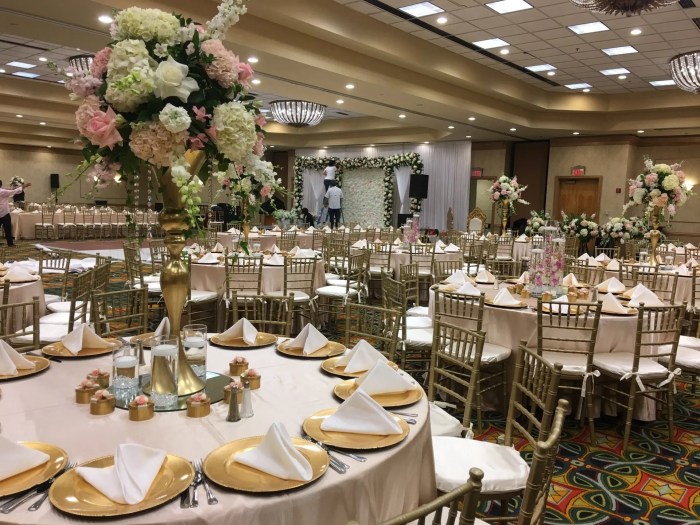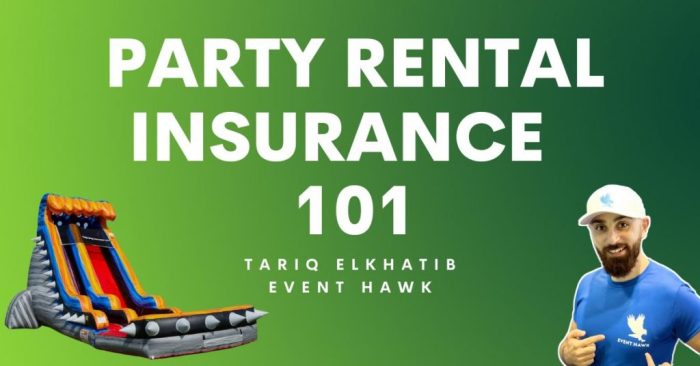Throwing a memorable party often involves renting equipment – from bouncy castles to sound systems. But what happens when an accident occurs, leaving you liable for significant damages? This is where party rental insurance steps in, offering a crucial safety net for both renters and rental businesses.
This comprehensive guide delves into the intricacies of party rental insurance, exploring coverage options, claims processes, and crucial risk mitigation strategies to ensure your next celebration is worry-free.
From understanding policy exclusions and navigating the claims process to selecting the right provider and implementing effective risk management techniques, this guide provides a clear roadmap for navigating the world of party rental insurance. We’ll examine the various factors influencing premium costs, analyze different coverage limits, and offer practical advice to protect your investment and avoid costly legal battles.
Defining Party Rental Insurance
Party rental insurance, a specialized form of liability coverage, protects businesses and individuals renting out equipment or venues for events against financial losses stemming from damage, theft, or liability claims. This crucial protection extends beyond basic renter’s insurance, specifically addressing the unique risks associated with the temporary transfer of possession of valuable assets and the potential for accidents during events.
Understanding its scope is vital for anyone involved in the party rental industry.Party rental insurance coverage comprehensively safeguards against a range of potential mishaps. It provides a financial safety net, mitigating the considerable financial burden that can arise from unforeseen circumstances.
The policy’s breadth of protection hinges on the specific terms and conditions, but generally includes several key elements.
Scope of Coverage
A typical party rental insurance policy offers protection against various scenarios. This includes coverage for damage to or loss of rented equipment, whether caused by accidents, negligence, or even acts of nature. Furthermore, it often extends to liability for bodily injury or property damage that occurs during the event held at the rented venue or due to the use of rented equipment.
This coverage is especially important, as liability claims can quickly escalate into significant financial liabilities. For example, a bouncy castle collapsing and injuring children could result in substantial legal fees and compensation payouts, all of which would be covered under a comprehensive policy.
Types of Events Covered
Party rental insurance typically covers a wide array of events, from intimate gatherings to large-scale celebrations. Commonly covered events include weddings, corporate events, birthday parties, festivals, and holiday celebrations. The specific types of events covered may vary depending on the insurer and the policy’s terms, but most policies are designed to be flexible and accommodate a diverse range of occasions.
Policies may even include exclusions for certain high-risk events, such as those involving extreme sports or hazardous materials.
Commonly Included Items
The specific items covered under a rental insurance policy will vary depending on the individual policy and the items rented. However, typical examples of equipment commonly included in such policies include tents, tables, chairs, sound systems, lighting equipment, inflatables (such as bouncy castles), and catering equipment.
Policies may also extend coverage to other related items, such as decorations or staging. It is crucial to review the specific policy wording to ascertain precisely which items are included in the coverage. A detailed inventory of rented items should be included as part of the insurance agreement.
This ensures clear understanding and minimizes disputes in case of claims.
Coverage Types and Limits

Party rental insurance policies offer a range of coverage options, each designed to protect renters from various financial risks associated with their events. Understanding these options and their limitations is crucial for securing adequate protection. The specific coverage and limits offered will vary depending on the insurer and the specifics of the rental agreement.
Liability Coverage
Liability coverage protects the renter against financial losses resulting from accidents or injuries sustained by guests at their event, or damage to third-party property. This is arguably the most important aspect of party rental insurance. A single incident, such as a guest tripping over a poorly placed inflatable bounce house, could lead to substantial medical bills and legal fees.
Liability coverage reimburses the renter for these costs, up to the policy’s limit.
Examples of Liability Coverage Scenarios
Several scenarios highlight the critical role of liability coverage. Imagine a child sustains a fracture while using a rented inflatable slide due to inadequate supervision or a malfunctioning component. Liability coverage would cover the medical expenses incurred. Similarly, if a rented tent collapses due to unforeseen weather conditions, injuring attendees or damaging nearby property, liability coverage would step in to compensate for damages.
Finally, consider a scenario where a guest spills a drink, causing damage to a homeowner’s expensive carpet. With adequate liability coverage, the renter would be protected from the cost of repairs.
Coverage Limits for Various Rental Items
The table below illustrates example coverage limits for various party rental items. Note that these are illustrative examples and actual limits will vary by insurer and policy. It is crucial to review the specific policy wording to understand the extent of coverage.
| Rental Item | Coverage Limit (USD) | Deductible (USD) | Notes |
|---|---|---|---|
| Inflatable Bounce House | 10,000 | 250 | Covers damage to the bounce house and liability for injuries. |
| Tents (Standard Size) | 5,000 | 100 | Covers damage to the tent and liability for injuries caused by its collapse. |
| Tables and Chairs (Set) | 1,000 | 50 | Covers damage or loss of the entire set. |
| Sound System | 2,500 | 150 | Covers damage or theft of the sound system. |
The Claims Process
Filing a claim for damaged or lost rental items under a party rental insurance policy typically involves a straightforward process, though the specifics may vary depending on the insurer and the policy details. Prompt notification and thorough documentation are key to a smooth and efficient claim resolution.The process generally begins with immediate reporting of the incident to the insurance provider.
This initial notification should include a detailed description of the event, the date and time of the occurrence, and a list of the affected rental items. Failure to report the incident promptly may impact the claim’s processing and eligibility for full coverage.
Claim Filing Procedures
After the initial notification, the insurer will typically provide instructions on how to formally file a claim. This usually involves completing a claim form, providing supporting documentation, and potentially cooperating with an adjuster’s investigation. The insurer may request additional information or clarification throughout the process.
For instance, some insurers may require photographs or videos of the damaged items, alongside the original rental agreement and any relevant police reports.
Required Documentation
A successful claim hinges on providing comprehensive and accurate documentation. This typically includes, but is not limited to:
- A completed claim form provided by the insurer.
- A copy of the rental agreement, clearly outlining the rental period, items rented, and the agreed-upon rental fees.
- Photographs or videos of the damaged or lost items, showing the extent of the damage or loss. High-resolution images are preferable, taken from multiple angles to provide a complete picture of the situation.
- Repair estimates or invoices from reputable repair shops, demonstrating the cost of repairing the damaged items. If the items are beyond repair, a detailed appraisal of their pre-loss value is needed.
- Police reports, if applicable, especially in cases of theft or vandalism. The report should clearly document the incident, including a case number and the date of the incident.
- Any other relevant documentation that supports the claim, such as witness statements or communications with the party responsible for the damage.
Claim Processing and Settlement Timeframes
The time it takes to process and settle a claim varies depending on the complexity of the claim and the insurer’s processing procedures. Simple claims with readily available documentation may be settled within a few weeks. More complex claims involving significant damage, disputes over liability, or extensive investigation could take several months to resolve.
Insurers typically Artikel their expected processing timelines in their policy documents. For example, a claim involving a minor scratch on a single chair might be processed within two weeks, while a claim involving a significant fire that destroyed a large tent and other equipment might take several months, especially if there’s an investigation into the cause of the fire and any potential disputes regarding liability.
Factors Affecting Insurance Premiums

Securing party rental insurance involves a multifaceted assessment of risk, ultimately influencing the premium charged. Several key factors contribute to the final cost, impacting both the affordability and comprehensiveness of the coverage. Understanding these factors empowers renters to make informed decisions and potentially negotiate favorable rates.Several factors interact to determine the final insurance premium.
These include the value of the rented items, the duration of the rental period, the location of the event, and the claims history of the renter. The insurer’s risk assessment process weighs these variables to establish a price that accurately reflects the potential for loss.
Rental Item Value
The inherent value of the rented items significantly impacts the premium calculation. Higher-value items, such as expensive sound systems, elaborate tents, or specialized catering equipment, present a greater risk of loss or damage, thus commanding higher premiums. Insurers typically use a valuation system, often based on replacement cost, to assess the risk.
For example, insuring a $10,000 sound system will inevitably cost more than insuring a $1,000 basic setup. This direct correlation between value and premium is a fundamental principle in risk assessment. The insurer’s assessment considers not just the initial cost but also the potential cost of repair or replacement.
Rental Period Length
The duration of the rental period directly correlates with the risk exposure. Longer rental periods increase the likelihood of damage or loss, resulting in higher premiums. A weekend rental will generally be less expensive to insure than a month-long rental of the same equipment.
This is because the longer the equipment is out of the insurer’s control, the higher the probability of an incident requiring a claim. Insurers often utilize a daily or weekly rate structure to reflect this escalating risk profile.
Event Location
The location of the rental event influences the premium. Events held in high-risk areas, characterized by higher crime rates or susceptibility to weather-related damage, attract higher premiums. An outdoor event in a hurricane-prone region, for example, will cost more to insure than a similar event in a more stable climate.
Insurers conduct thorough risk assessments based on geographical data and historical claims information to account for location-specific hazards.
Renter’s Claims History
Similar to auto insurance, a renter’s past claims history can significantly impact their premiums. A history of frequent or substantial claims may lead to higher premiums, reflecting the increased risk associated with the renter. Insurers maintain records of past claims, using this data to assess the likelihood of future claims.
A clean claims history often translates to lower premiums, demonstrating the importance of responsible rental practices.
Comparison of Premium Rates Across Providers
Premium rates vary considerably across different insurance providers. Factors such as the insurer’s risk appetite, market competitiveness, and specific policy features contribute to this variation. Obtaining quotes from multiple insurers is crucial for securing the most competitive rate.
It’s not uncommon to see significant differences in premiums for the same coverage from different providers, emphasizing the importance of a thorough comparison before committing to a policy. For example, one insurer might specialize in high-value rentals and offer competitive rates in that niche, while another may focus on smaller-scale events.
Choosing the Right Insurance Provider

Selecting the appropriate party rental insurance provider is crucial for securing adequate coverage and ensuring a smooth claims process. A poorly chosen provider can leave your business vulnerable to significant financial losses in the event of damage, theft, or liability claims.
Careful consideration of several factors will significantly reduce risk and improve your overall insurance experience.Finding a reputable provider involves a multi-faceted approach, balancing factors such as coverage breadth, claims handling efficiency, and financial stability. Providers differ substantially in their policy offerings, pricing structures, and customer service responsiveness.
Thorough research and comparative analysis are essential to make an informed decision that aligns with your specific needs and budget.
Provider Reputation and Financial Stability
Assessing a provider’s reputation involves reviewing online reviews, checking their rating with independent agencies like A.M. Best (a credit rating agency specializing in the insurance industry), and verifying their licensing and regulatory compliance. A strong financial rating indicates the provider’s ability to meet its obligations in the event of a significant claim.
Consider researching the provider’s history, looking for evidence of consistent customer satisfaction and prompt claim settlements. For example, a provider with numerous complaints filed against them with the state insurance department might indicate a less reliable choice.
Coverage Options and Policy Exclusions
Different providers offer varying levels of coverage and specific exclusions. Some may offer broader coverage for liability, while others might focus more on property damage. Carefully examine the policy wording to understand precisely what is and isn’t covered.
For instance, some policies might exclude certain types of equipment or limit coverage for specific events. Comparing policy documents from multiple providers will highlight these critical differences and allow for a more informed selection. A clear understanding of exclusions is essential to avoid gaps in coverage.
Claims Process and Customer Service
The claims process should be straightforward and efficient. Inquire about the provider’s claims handling procedures, including the required documentation, timelines for processing, and methods of communication. Positive customer service experiences, including prompt responses to inquiries and helpful guidance, are indicative of a reliable provider.
Consider reading online testimonials or reviews to gauge the general experience of other clients. A provider with a reputation for slow or difficult claims processing may present unnecessary challenges during a critical time.
Questions to Ask Potential Insurance Providers
Before selecting a provider, compile a list of key questions to ensure a complete understanding of their offerings. These questions should address the scope of coverage, policy exclusions, claims procedures, pricing structure, and customer service protocols. For example, inquire about their experience with party rental insurance specifically, the availability of additional riders or endorsements, and the process for appealing a claim denial.
Clarifying these aspects upfront helps avoid potential misunderstandings or disappointments later.
Understanding Policy Exclusions

Party rental insurance, while offering crucial protection, doesn’t cover every eventuality. Understanding policy exclusions is paramount to avoid costly surprises. A thorough review of the policy document before purchasing is essential to ensure the coverage aligns with your specific needs and risk profile.Policy exclusions represent situations or items explicitly not covered by the insurance agreement.
These exclusions are carefully defined within the policy wording and are designed to manage risk and prevent fraudulent claims. Ignoring these exclusions could lead to significant financial liability in the event of a covered loss.
Common Exclusions in Party Rental Insurance Policies
Standard party rental insurance policies typically exclude coverage for certain types of damage or loss. These exclusions often relate to predictable risks or situations where liability is difficult to determine. Failure to understand these limitations can result in significant out-of-pocket expenses.
- Acts of God:This commonly excludes damage caused by natural disasters such as hurricanes, earthquakes, floods, or tornadoes. For example, if a tent is destroyed by a tornado, the damage might not be covered.
- Wear and Tear:Normal wear and tear on rental equipment is usually not covered. This means minor scratches or dents resulting from typical use are the responsibility of the renter.
- Intentional Damage:Damage caused deliberately by the renter or their guests is typically excluded. Vandalism or intentional destruction of equipment falls under this category.
- Mechanical Breakdown:Coverage often excludes mechanical failures of equipment due to pre-existing conditions or lack of proper maintenance. A generator failing due to a pre-existing fault, for instance, may not be covered.
- Theft without Evidence of Forced Entry:Some policies exclude theft unless there’s evidence of forced entry. Simply missing equipment without signs of a break-in may not be covered.
Examples of Uncovered Events and Items
Understanding specific examples of excluded events and items clarifies the scope of coverage. It highlights the importance of carefully comparing different policies and selecting one that aligns with the specific risks associated with your rental business.
- A catering company’s liability for food poisoning:While party rental insurance covers damage to rented equipment, it generally does not extend to the liability of third-party vendors like caterers.
- Damage caused by a guest’s negligence:If a guest damages a rented item through carelessness, but not intentional destruction, coverage might still be excluded, depending on policy specifics.
- Loss of income due to equipment malfunction:While some policies may offer business interruption coverage as an add-on, standard party rental insurance typically does not cover lost revenue from equipment failure.
- Pre-existing damage to equipment:Any damage to equipment that existed before the rental period typically won’t be covered by the insurance.
Importance of Reviewing Policy Documents
Before finalizing any party rental insurance policy, meticulously reviewing the policy document is crucial. This involves carefully reading the fine print, understanding the exclusions, and confirming that the coverage meets your specific needs. Seeking clarification from the insurance provider on any unclear aspects is highly recommended.
Ignoring this step can lead to significant financial losses in the event of a claim. A clear understanding of the policy’s limitations is essential for responsible risk management in the party rental business.
Legal Considerations and Compliance

Party rental insurance is not merely a financial safeguard; it’s a crucial component of legal compliance and risk mitigation for businesses operating in this sector. Understanding the legal landscape and adhering to relevant regulations are essential for avoiding costly lawsuits and maintaining a reputable operation.
Failure to do so can lead to significant financial and reputational damage.The legal aspects of renting party equipment are multifaceted, encompassing contract law, product liability, and general business regulations. Insurance plays a pivotal role in protecting rental businesses from potential liabilities arising from accidents, injuries, or property damage involving rented equipment.
Furthermore, compliance with local, state, and potentially federal regulations, including those concerning safety standards and consumer protection, is paramount.
Contractual Obligations and Liability
Rental agreements form the bedrock of the party rental business. These contracts must clearly Artikel the terms of rental, including the renter’s responsibilities, the duration of the rental period, payment terms, and conditions regarding damage or loss of equipment.
Comprehensive insurance coverage protects the rental business from potential losses arising from breach of contract or disputes over the condition of returned equipment. For example, a poorly worded contract could leave a rental company liable for damages caused by a renter’s negligence even if the company’s equipment was not directly at fault.
Insurance can help mitigate this risk.
Product Liability and Safety Standards
Rental companies bear a responsibility to ensure the safety of their equipment. Defective equipment or equipment that fails to meet safety standards can lead to serious accidents and injuries, resulting in significant legal liabilities. Product liability insurance is crucial in covering claims arising from such incidents.
A specific example would be a bounce house collapsing due to a manufacturing defect or inadequate maintenance, leading to injuries to children. Without adequate insurance, the rental company could face substantial legal costs and compensation payouts.
Compliance with Business Regulations
Party rental businesses are subject to various regulations, depending on their location and the type of equipment they rent. These regulations may cover aspects such as business licensing, tax compliance, and adherence to safety standards for specific equipment types. Failure to comply with these regulations can result in fines, penalties, and even business closure.
Maintaining comprehensive insurance demonstrates a commitment to responsible business practices and can help mitigate the financial impact of regulatory non-compliance. For instance, failure to obtain the necessary permits for operating a particular type of equipment can lead to significant fines and legal challenges.
Insurance, while not directly covering the fines, can help offset the costs associated with the legal battle and business disruption.
Examples of Legal Issues Without Adequate Insurance
Consider a scenario where a renter injures themselves on faulty equipment. Without adequate liability insurance, the rental company could face a lawsuit demanding substantial compensation for medical expenses, lost wages, and pain and suffering. Similarly, if a fire caused by malfunctioning equipment damages a client’s property, the lack of insurance could lead to devastating financial consequences for the rental business.
In another scenario, a customer might sue due to a breach of contract, claiming the rental company failed to deliver equipment as promised. Without appropriate insurance, the business would bear the entire cost of resolving the legal dispute and compensating the customer.
Risk Management Strategies for Renters
Proactive risk management is crucial for party rental businesses to mitigate potential losses and maintain profitability. Implementing effective strategies minimizes the likelihood of equipment damage, theft, or loss, ultimately reducing insurance claims and preserving financial stability. This section Artikels preventative measures, checklists, and inspection procedures to enhance operational efficiency and minimize risk.
Preventative Measures to Minimize Rental Equipment Damage or Loss
Implementing preventative measures significantly reduces the risk of damage or loss to rental equipment. These measures should be integrated into every stage of the rental process, from initial inventory management to post-rental inspection. A comprehensive approach combines employee training, equipment maintenance, and robust security protocols.
- Regular Equipment Maintenance: Scheduled maintenance, including cleaning, inspection, and necessary repairs, extends equipment lifespan and reduces the likelihood of malfunctions during rentals. This should include pre-rental checks of all equipment functionality.
- Thorough Employee Training: Equipping employees with proper handling and safety procedures is paramount. Training should cover safe operation, transportation, and storage of all rental items. Regular refresher courses reinforce best practices.
- Secure Storage Facilities: Rental equipment should be stored in secure, climate-controlled facilities to protect against theft, damage from the elements, and vandalism. Surveillance systems and access controls further enhance security.
- High-Quality Equipment: Investing in durable, high-quality equipment minimizes the risk of breakdowns and premature wear and tear. While initial costs are higher, the long-term savings in repairs and replacements are significant.
- Detailed Rental Agreements: Clearly defined rental agreements outlining responsibilities, damage liability, and insurance coverage protect both the renter and the rental company. These agreements should be reviewed and signed by both parties before each rental.
Rental Equipment Handling Checklist
A comprehensive checklist ensures consistent and thorough handling of rented items, minimizing the potential for damage or loss. This checklist should be provided to and completed by the renter at both the pickup and return of the equipment. Discrepancies should be noted and addressed immediately.
- Pre-Rental Inspection: A detailed inspection of the equipment’s condition, noting any pre-existing damage, is crucial. Both the renter and the rental company representative should sign and date the inspection report.
- Safe Transportation: Proper transportation procedures, including securing the equipment to prevent shifting or damage during transit, should be Artikeld and followed.
- Safe Operation Instructions: Clear and concise instructions on the safe and proper operation of each piece of equipment should be provided and reviewed with the renter.
- Designated Operator: Specify a designated, trained operator for each piece of equipment to ensure proper handling and minimize the risk of accidents.
- Post-Rental Inspection: A thorough post-rental inspection, comparing the equipment’s condition to the pre-rental inspection report, identifies any damage incurred during the rental period.
Importance of Thorough Inspections Before and After Rentals
Pre- and post-rental inspections are critical for establishing the equipment’s condition and determining liability for any damage. A meticulous inspection process minimizes disputes and ensures accurate assessment of any damages. Detailed photographic documentation should accompany each inspection report.
- Pre-Rental Inspection: This establishes a baseline condition, documenting existing wear and tear. Photographs are essential for comparison with the post-rental inspection.
- Post-Rental Inspection: This identifies any new damage or loss, facilitating the determination of responsibility and the assessment of repair costs. Again, detailed photographic documentation is vital.
- Documentation: Comprehensive documentation, including signed inspection reports and photographic evidence, protects both the renter and the rental company in case of disputes.
Illustrative Scenarios and Case Studies
Real-world examples highlight the critical role of party rental insurance in mitigating financial losses and ensuring business continuity for rental companies. Analyzing specific scenarios reveals the significant benefits of adequate coverage and underscores the importance of comprehensive policy selection.A crucial aspect of understanding the value proposition of party rental insurance lies in examining specific instances where it proved indispensable.
Case studies, detailing both the events leading to claims and the subsequent resolutions, provide invaluable insights for prospective policyholders.
Scenario: Severe Weather Damage to Inflatable Rental
A children’s party rental company, “FunFolds,” rented a large inflatable bounce house for a weekend birthday celebration. Unexpected severe thunderstorms hit the area, causing significant damage to the inflatable. Strong winds ripped a large gash in the side of the bounce house, rendering it unusable.
Without party rental insurance, FunFolds would have faced substantial financial losses, covering the cost of the damaged inflatable, potentially including lost rental income from future bookings. However, due to their comprehensive insurance policy, FunFolds filed a claim, and the insurance provider covered the cost of repairs, minimizing their financial burden and allowing them to maintain business operations.
The quick and efficient claims process also helped maintain customer satisfaction.
Case Study: Theft and Vandalism of High-Value Equipment
“Elegant Events,” a high-end party rental business specializing in upscale weddings and corporate functions, experienced a significant setback when a substantial amount of their equipment was stolen and vandalized from a secure storage facility. The theft included high-value items such as crystal glassware, designer linens, and professional-grade sound equipment.
The total value of the lost and damaged items exceeded $50,000. Their comprehensive party rental insurance policy, which included coverage for theft and vandalism, covered the full replacement cost of the stolen items and the repairs of the damaged equipment.
This prevented a potentially devastating financial blow and allowed Elegant Events to continue operations without interruption, fulfilling existing bookings and maintaining their reputation.
Damaged Rental Item and Claim Process Illustration
The image depicts a significantly damaged antique wooden bar, a key rental item for a high-end event planning company. The bar, originally polished to a high sheen, shows significant gouges and scratches across its surface. A large section of the wood is splintered, revealing the underlying structure.
A close-up reveals spilled red wine stains deeply embedded into the wood. The image also shows the claim form, partially filled out, with details of the damage, an estimated repair cost, and accompanying photographs of the damage. The claim process involved submitting the completed claim form, along with photographic evidence of the damage and a detailed description of the incident.
The insurance company assessed the claim, verified the extent of the damage, and approved the claim for repair or replacement, depending on the feasibility and cost-effectiveness of each option. The prompt settlement of the claim minimized the financial impact on the rental company and allowed them to replace the damaged bar with a similar item, ensuring they could continue to fulfill their rental commitments.
Final Review
Securing adequate party rental insurance is not merely a precautionary measure; it’s a strategic investment in the success of your event. By understanding the nuances of coverage, claims procedures, and risk management, you can confidently navigate potential challenges and ensure a smooth, enjoyable experience.
Remember, thorough research, careful policy review, and proactive risk mitigation are key to leveraging the protective power of party rental insurance and avoiding potential financial pitfalls. Don’t let unforeseen circumstances overshadow your celebration; protect your investment and your peace of mind.

